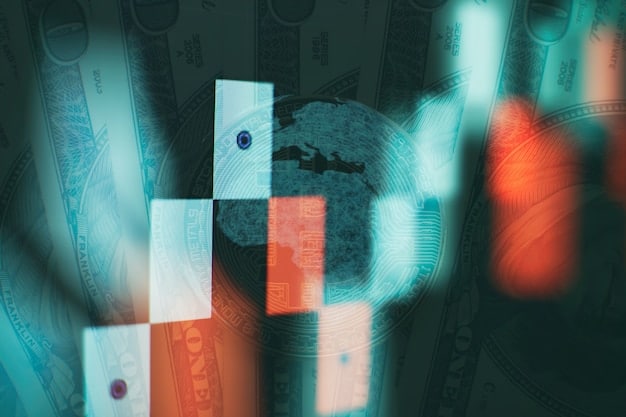Predicting the 2025 Oscars: A Data-Driven Movie Review Analysis

Predicting the Oscar Winners: A Data-Driven Analysis of 2025 Movie Reviews leverages statistical models, sentiment analysis of critic reviews, and historical trends to forecast potential winners, offering a comprehensive look at the intertwined relationship between data and awards season success.
The quest to foresee the Academy Awards outcomes has always been driven by gut feelings, insider information, and, quite frankly, a bit of luck. But what if we could minimize the guesswork by using data? This article delves into the world of Predicting the Oscar Winners: A Data-Driven Analysis of 2025 Movie Reviews, showcasing how algorithms and critical analysis can meet to predict who will take home the golden statue.
How Data Science is Transforming Oscar Predictions
Historically, predicting Oscar winners was the turf of movie critics and industry insiders. Their assessments, while insightful, were inherently subjective. Data science offers a new, quantifiable dimension to this game, transforming it from a guessing game into a sophisticated analytical exercise.
The application of data science in predicting Oscars leverages various methodologies. Statistical models, like regression analysis, can correlate factors like box office success, critic scores, and award nominations to predict winners. Natural Language Processing (NLP) is instrumental in conducting sentiment analysis on thousands of movie reviews to gauge public and critical attitudes towards films and actors.
Key Data Points in Oscar Prediction
Several key data points are crucial for data-driven Oscar predictions. These include:
- Box Office Performance: Movies that perform well at the box office often have a higher chance of winning, indicating popularity and broader appeal.
- Critical Acclaim: Measured through aggregate scores from sites like Metacritic and Rotten Tomatoes, critical acclaim is a significant predictor.
- Previous Award Wins: Wins at other prestigious awards, such as the Golden Globes and BAFTAs, often foreshadow Oscar success.
- Social Media Sentiment: Analyzing social media buzz can provide insights into public perception and emotional responses to movies and performances.

By carefully analyzing these data points, predictive models can be built to forecast Oscar winners with a surprising degree of accuracy. This shift towards data-driven analysis marks a significant change in how the Oscars are approached and understood.
In conclusion, data science is revolutionizing how we predict Oscar winners, moving away from subjective opinions towards objective assessments. By analyzing various data points, predictive models can offer insights that are both fascinating and surprisingly accurate.
Analyzing Movie Reviews: Sentiment and Impact
Movie reviews play a critical role in shaping public perception and influencing awards. Analyzing these reviews goes beyond simply counting positive or negative feedback; it involves understanding the nuances of sentiment and assessing the impact of critical opinion.
Sentiment analysis is a technique used to determine the emotional tone behind a piece of text. In the context of movie reviews, it involves using NLP to categorize reviews as positive, negative, or neutral, and even to gauge the intensity of these sentiments. This process helps in quantifying the overall critical reception of a film.
The Power of Sentiment Analysis
Understanding the subtleties of sentiment is essential because:
- It Provides a Comprehensive View: Sentiment analysis offers a more nuanced understanding of critical reception than simple ratings.
- It Identifies Key Strengths and Weaknesses: By analyzing specific phrases and keywords, sentiment analysis can pinpoint what reviewers liked or disliked about a film.
- It Gauges Public and Critical Alignment: Comparing sentiment analysis results with audience reviews can reveal whether critics and the public agree on a film’s merits.
The impact of movie reviews is substantial, influencing not only box office success but also Oscar nominations and wins. Films that receive widespread critical acclaim often have a higher likelihood of attracting attention from the Academy. Furthermore, positive reviews can create a buzz around a film, increasing its visibility and appeal.
In summary, sentiment analysis of movie reviews offers valuable insights into a film’s critical reception and its potential impact on awards. By understanding the nuances of sentiment and assessing the influence of critical opinion, we can better predict which films will resonate with both audiences and the Academy.
Building a Predictive Model for the 2025 Oscars
Creating a predictive model for the Oscars involves a systematic approach, combining data collection, feature engineering, model selection, and validation. The goal is to build a model that accurately forecasts the winners based on historical data and current trends.
The initial step is to gather relevant data. This includes box office numbers, critic scores from various sources (e.g., Metacritic, Rotten Tomatoes), award nominations from other ceremonies (e.g., Golden Globes, BAFTAs), and social media sentiment. Historical data from previous years is also crucial to identify patterns and trends.

Steps to Building a Predictive Model
Here’s a breakdown of the essential steps:
- Data Collection: Aggregate comprehensive information from various sources related to nominated films.
- Feature Engineering: Design and select characteristics (features) that the model should take into account.
- Model Selection: Decide which algorithm to use: Logistic Regression, Random Forest, and Neural Networks, are possible candidates.
- Model Training: Use historical data to train the model, adjusting parameters to optimize predictive accuracy. Then test your model.
Validating the model is essential to ensure its accuracy and reliability. This involves using a portion of the data (e.g., data from previous years) to test the model’s predictions and fine-tune it accordingly. Common validation techniques include cross-validation and backtesting.
In conclusion, building a predictive model for the Oscars is a complex but rewarding process. By carefully collecting data, engineering features, selecting an appropriate model, and validating its performance, we can create a powerful tool for forecasting Oscar winners.
The Role of Historical Trends in Oscar Predictions
Historical trends offer valuable insights into the patterns and biases that influence Oscar outcomes. Analyzing these trends can enhance the accuracy of predictive models and provide a deeper understanding of the Academy’s preferences.
Certain trends have consistently influenced Oscar decisions. For example, films with strong social or political messages often fare well, reflecting the Academy’s inclination towards movies that address important issues. Similarly, films that receive widespread critical acclaim and win major awards at other ceremonies tend to perform well at the Oscars.
Recognizing Recurring Patterns
Key historical trends to consider include:
- Genre Preferences: Certain genres, such as dramas and historical epics, often receive more attention from the Academy.
- Director Influence: Films directed by acclaimed directors with a track record of Oscar success tend to perform well.
- Acting Performances: Strong lead performances, particularly those that showcase range and depth, often win awards.
However, it’s important to note that historical trends are not foolproof. The Academy’s preferences can evolve over time, influenced by changing social and cultural contexts. Therefore, it’s essential to combine historical analysis with current data and sentiment analysis to create a more comprehensive predictive model. For example, in recent years, there has been a growing emphasis on diversity and inclusion, which has impacted nomination and award decisions.
In summary, historical trends play a significant role in Oscar predictions, providing valuable insights into the Academy’s preferences and biases. By analyzing these trends and combining them with current data and sentiment analysis, we can improve the accuracy of predictive models and gain a deeper understanding of the factors that influence Oscar outcomes.
Challenges and Limitations of Data-Driven Predictions
While data-driven predictions can offer valuable insights, they are not without their challenges and limitations. Understanding these limitations is crucial for interpreting predictions accurately and avoiding overreliance on statistical models.
One of the primary challenges is the potential for bias in the data. Historical data may reflect existing biases in the industry, such as underrepresentation of certain groups or preferences for certain types of films. If the predictive model is trained on biased data, it may perpetuate these biases in its predictions.
Potential Pitfalls of Data Analysis
Some notable limitations include:
- Data Availability and Quality: Access to comprehensive and reliable data can be limited, impacting the accuracy of the model.
- Overfitting: Predictive models can sometimes be too closely tailored to the training data, leading to poor performance on new data.
- Unpredictable Factors: External factors, such as unexpected events or controversies, can influence Oscar outcomes in ways that are difficult to predict.
Ethical considerations are also important. It’s crucial to ensure that data is collected and used in a responsible and transparent manner, respecting privacy and avoiding discrimination. Additionally, it’s important to recognize that data-driven predictions are not definitive; they are simply estimates based on available information.
In conclusion, while data-driven predictions can be a powerful tool for forecasting Oscar winners, it’s essential to be aware of their challenges and limitations. By understanding these limitations and addressing potential biases, we can interpret predictions more accurately and avoid overreliance on statistical models.
Future Trends in Data Science and Oscar Predictions
The intersection of data science and Oscar predictions is an evolving field, with new technologies and methodologies constantly emerging. These advancements promise to further enhance the accuracy and sophistication of predictive models.
One of the most promising trends is the increasing use of machine learning and artificial intelligence (AI). Machine learning algorithms can analyze vast amounts of data and identify complex patterns that humans may miss. AI-powered systems can also automate many of the tasks involved in building and validating predictive models, making the process more efficient.
What’s Next in Predictive Analysis?
Emerging trends include:
- Advanced NLP Techniques: More sophisticated NLP methods can better understand the nuances of movie reviews and social media sentiment.
- Personalized Predictions: Tailoring predictions to individual preferences and biases can increase the relevance and accuracy of forecasts.
- Real-Time Data Analysis: Integrating real-time data streams can provide up-to-date insights into public opinion and award buzz.
Additionally, the growing availability of data and the increasing computational power will enable the development of more complex and accurate predictive models. As data science continues to advance, we can expect to see even more innovative applications in the world of Oscar predictions. This includes the use of virtual reality and augmented reality to create immersive experiences that enhance the viewing and analytical process.
In summary, the future of data science and Oscar predictions is bright, with new technologies and methodologies promising to further enhance the accuracy and sophistication of predictive models. By embracing these advancements, we can gain even deeper insights into the factors that influence Oscar outcomes.
| Key Aspect | Brief Description |
|---|---|
| 📊 Data-Driven Approach | Employs statistical models and sentiment analysis for predictions. |
| 🎬 Movie Review Impact | Analyzes sentiment in reviews to gauge critical reception and influence. |
| 🏆 Historical Trends | Considers recurring patterns and biases in past Oscar outcomes. |
| 🤖 Future of AI | Emerging trends like machine learning enhance prediction models. |
Frequently Asked Questions
▼
Box office performance, critical acclaim (Metacritic, Rotten Tomatoes), prior awards (Golden Globes, BAFTAs), and social media sentiment are key. These metrics provide a holistic view.
▼
Sentiment analysis quantifies the emotional tone of movie reviews, offering nuanced insights beyond simple ratings and identifying strengths and weaknesses in films.
▼
Limitations include potential data bias, overfitting, unpredictable external factors, and ethical considerations related to data collection and usage transparency.
▼
Historical trends identify patterns and biases in Oscar outcomes. Incorporating these trends with current data improves model accuracy by recognizing genre preferences, director influence, etc.
▼
Advanced NLP techniques, personalized predictions, and real-time data analysis are emerging. Machine learning and AI innovations will enhance accuracy and efficiency in predictions.
Conclusion
Predicting the Oscar winners using data-driven analysis is an intricate yet increasingly reliable method. By harnessing statistical models, dissecting movie reviews through sentiment analysis, recognizing historical trends, and acknowledging the limitations and challenges, a clearer picture emerges. As data science evolves, the accuracy and sophistication of these predictions promise to enhance, offering enthusiasts and industry professionals alike a novel perspective on the Academy Awards.





